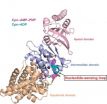(Press-News.org) LOS ALAMOS, New Mexico, February 24, 2012—A multinational team of scientists has developed a process for creating glass-based, inorganic light-emitting diodes (LEDs) that produce light in the ultraviolet range. The work, reported this week in the online Nature Communications, is a step toward biomedical devices with active components made from nanostructured systems.
LEDs based on solution-processed inorganic nanocrystals have promise for use in environmental and biomedical diagnostics, because they are cheap to produce, robust, and chemically stable. But development has been hampered by the difficulty of achieving ultraviolet emission. In their paper, Los Alamos National Laboratory's Sergio Brovelli in collaboration with the research team lead by Alberto Paleari at the University of Milano-Bicocca in Italy describe a fabrication process that overcomes this problem and opens the way for integration in a variety of applications.
The world needs light-emitting devices that can be applied in biomedical diagnostics and medicine, Brovelli said, either as active lab-on-chip diagnostic platforms or as light sources that can be implanted into the body to trigger some photochemical reactions. Such devices could, for example, selectively activate light-sensitive drugs for better medical treatment or probe for the presence of fluorescent markers in medical diagnostics. These materials would need to be fabricated cheaply, on a large scale, and integrated into existing technology.
The paper describes a new glass-based material, able to emit light in the ultraviolet spectrum, and be integrated onto silicon chips that are the principal components of current electronic technologies.
The new devices are inorganic and combine the chemical inertness and mechanical stability of glass with the property of electric conductivity and electroluminescence (i.e. the ability of a material to emit light in response to the passage of an electric current).
As a result, they can be used in harsh environments, such as for immersion into physiologic solutions, or by implantation directly into the body. This was made possible by designing a new synthesis strategy that allows fabrication of all inorganic LEDs via a wet-chemistry approach, i.e. a series of simple chemical reactions in a beaker. Importantly, this approach is scalable to industrial quantities with a very low start-up cost. Finally, they emit in the ultraviolet region thanks to careful design of the nanocrystals embedded in the glass.
In traditional light-emitting diodes, light emission occurs at the sharp interface between two semiconductors. The oxide-in-oxide design used here is different, as it allows production of a material that behaves as an ensemble of semiconductor junctions distributed in the glass.
This new concept is based on a collection of the most advanced strategies in nanocrystal science, combining the advantages of nanometric materials consisting of more than one component. In this case the active part of the device consists of tin dioxide nanocrystals covered with a shell of tin monoxide embedded in standard glass: by tuning the shell thickness is it possible to control the electrical response of the whole material.
INFORMATION:
The paper was produced with the financial support of Cariplo Foundation, Italy, under Project 20060656, the Russian Federation under grant 11.G34.31.0027, the Silvio Tronchetti Provera Foundation, and Los Alamos National Laboratory's Directed Research and Development Program.
The paper is titled, "Fully inorganic oxide-in-oxide ultraviolet nanocrystal light emitting devices," and can be downloaded from the following online Nature Communications link: http://dx.doi.org/10.1038/ncomms1683
Its authors are Sergio Brovelli1, 2, Norberto Chiodini1, Roberto Lorenzi1, Alessandro Lauria1, Marco Romagnoli3,4& Alberto Paleari1
1. Department of Materials Science, University of Milano-Bicocca, Italy.
2. Chemistry Division, Los Alamos National Laboratory, Los Alamos, New Mexico.
3. Material Processing Center, Massachusetts Institute of Technology, Cambridge, Massachusetts..
4. On leave from Photonic Corp, Culver City, California.
Light-emitting nanocrystal diodes go ultraviolet
Biomedical device potential for robust, implantable product
2012-02-27
ELSE PRESS RELEASES FROM THIS DATE:
Astrophysicists from Clemson University and Europe unmask a black hole
2012-02-27
CLEMSON — A study of X-rays emitted a long time ago in a galaxy far, far away has unmasked a stellar mass black hole in Andromeda, a spiral galaxy about 2.6 million light-years from Earth.
Two Clemson University researchers joined an an international team of astronomers, including scientists at Germany's Max Planck Institute for Extraterrestrial Physics, in publishing their findings in a pair of scientific journals this week.
Scientists had suspected the black hole was possible since late 2009 when an X-ray satellite observatory operated by the Max Planck Institute ...
The emotional oracle effect
2012-02-27
NEW YORK – February 24, 2012 – A forthcoming article in the Journal of Consumer Research by Professor Michel Tuan Pham, Kravis Professor of Business, Marketing, Columbia Business School; Leonard Lee, Associate Professor, Marketing, Columbia Business School; and Andrew Stephen, PhD '09, currently Assistant Professor of Business Administration, Joseph M. Katz Graduate School of Business, University of Pittsburgh, finds that a higher trust in feelings may result in more accurate predictions about a variety of future events. The research will also be featured in Columbia Business ...
Correct protein folding
2012-02-27
The gold standard for nanotechnology is nature's own proteins. These biomolecular nanomachines – macromolecules forged from peptide chains of amino acids - are able to fold themselves into a dazzling multitude of shapes and forms that enable them to carry out an equally dazzling multitude of functions fundamental to life. As important as protein folding is to virtually all biological systems, the mechanisms behind this process have remained a mystery. The fog, however, is being lifted.
A team of researchers with the U.S. Department of Energy (DOE)'s Lawrence Berkeley ...
Statins linked with lower depression risk in heart patients
2012-02-27
Patients with heart disease who took cholesterol-lowering statins were significantly less likely to develop depression than those who did not, in a study by Mary Whooley, MD, a physician at the San Francisco VA Medical Center and a professor of medicine at the University of California, San Francisco.
The study was published electronically in the Journal of Clinical Psychiatry (February 21, 2012).
Whooley and her research team evaluated 965 heart disease patients for depression, and found that the patients who were on statins were significantly less likely to be clinically ...
Study proposes new measure of world equity market segmentation
2012-02-27
NEW YORK – February 24, 2012 – A recent study in the Review of Financial Studies proposes a new, valuation-based measure of equity market segmentation. Equity market segmentation occurs when stocks of similar risk in different countries are priced differently. The study, by Columbia Business School Professor Geert Bekaert, Chazen Senior Scholar at The Jerome A. Chazen Institute of International Business at Columbia Business School and the Leon G. Cooperman Professor of Finance and Economics, uncovers the factors that cause variation in market segmentation, both through ...
Rethinking the social structure of ancient Eurasian nomads: Current Anthropology research
2012-02-27
Prehistoric Eurasian nomads are commonly perceived as horse riding bandits who utilized their mobility and military skill to antagonize ancient civilizations such as the Chinese, Persians, and Greeks. Although some historical accounts may support this view, a new article by Dr. Michael Frachetti (Washington University, St. Louis) illustrates a considerably different image of prehistoric pastoralist societies and their impact on world civilizations more than 5000 years ago.
In the article, recently published in the February issue of Current Anthropology, Frachetti argues ...
New research points to erosional origin of linear dunes
2012-02-27
Boulder, Colorado, USA - Linear dunes, widespread on Earth and Saturn's moon, Titan, are generally considered to have been formed by deposits of windblown sand. It has been speculated for some time that some linear dunes may have formed by "wind-rift" erosion, but this model has commonly been rejected due to lack of sufficient evidence. Now, new research supported by China's NSF and published this week in GSA BULLETIN indicates that erosional origin models should not be ruled out.
The linear dunes in China's Qaidam Basin have been proposed to have formed as self-extending ...
GSA Bulletin: Alaska, Russia, Tibet, the Mississippi River, and the Great Green River Basin
2012-02-27
Boulder, CO, USA - New GSA BULLETIN science published online 24 Feb. includes work on the Chugach Metamorphic Complex of southern Alaska; news and data from the first non-Russian science team to make a helicopter over-flight of Shiveluch volcano in Kamchatka, Russia, after its large 2005 eruption; and a study by a team from the Lamont-Doherty Earth Observatory that proposes a new calibration model for the Eocene segment of the Geomagnetic Polarity Time Scale (GPTS).
Large-scale, short-lived metamorphism, deformation, and magmatism in the Chugach metamorphic complex, ...
Study shows significant state-by-state differences in black, white life expectancy
2012-02-27
A UCLA-led group of researchers tracing disparities in life expectancy between blacks and whites in the U.S. has found that white males live about seven years longer on average than African American men and that white women live more than five years longer than their black counterparts.
But when comparing life expectancy on a state-by-state basis, the researchers made a surprising discovery: In those states in which the disparities were smallest, the differences often were not the result of African Americans living longer but of whites dying younger than the national ...
Training parents is good medicine for children with autism behavior problems
2012-02-27
Children with autism spectrum disorders who also have serious behavioral problems responded better to medication combined with training for their parents than to treatment with medication alone, Yale researchers and their colleagues report in the February issue of Journal of the American Academy of Child & Adolescent Psychiatry.
"Serious behavioral problems interfere with everyday living for children and their families," said senior author on the study Lawrence Scahill, professor at Yale University School of Nursing and the Child Study Center. "Decreasing these serious ...
LAST 30 PRESS RELEASES:
The Ceramic Society of Japan’s Oxoate Ceramics Research Association launches new international book project
Heart-brain connection: international study reveals the role of the vagus nerve in keeping the heart young
Researchers identify Rb1 as a predictive biomarker for a new therapeutic strategy in some breast cancers
Survey reveals ethical gaps slowing AI adoption in pediatric surgery
Stimulant ADHD medications work differently than thought
AI overestimates how smart people are, according to HSE economists
HSE researchers create genome-wide map of quadruplexes
Scientists boost cell "powerhouses" to burn more calories
Automatic label checking: The missing step in making reliable medical AI
Low daily alcohol intake linked to 50% heightened mouth cancer risk in India
American Meteorological Society announces Rick Spinrad as 2026 President-Elect
Biomass-based carbon capture spotlighted in newly released global climate webinar recording
Illuminating invisible nano pollutants: advanced bioimaging tracks the full journey of emerging nanoscale contaminants in living systems
How does age affect recovery from spinal cord injury?
Novel AI tool offers prognosis for patients with head and neck cancer
Fathers’ microplastic exposure tied to their children’s metabolic problems
Research validates laboratory model for studying high-grade serous ovarian cancer
SIR 2026 delivers transformative breakthroughs in minimally invasive medicine to improve patient care
Stem Cell Reports most downloaded papers of 2025 highlight the breadth and impact of stem cell research
Oxford-led study estimates NHS spends around 3% of its primary and secondary care budget on the health impacts of heat and cold in England
A researcher’s long quest leads to a smart composite breakthrough
Urban wild bees act as “microbial sensors” of city health.
New study finds where you live affects recovery after a hip fracture
Forecasting the impact of fully automated vehicle adoption on US road traffic injuries
Alcohol-related hospitalizations from 2016 to 2022
Semaglutide and hospitalizations in patients with obesity and established cardiovascular disease
Researchers ‘listen in’ to embryo-mother interactions during implantation using a culture system replicating the womb lining
How changing your diet could help save the world
How to make AI truly scalable and reliable for real-time traffic assignment?
Beyond fragmented markets: A new framework for efficient and stable ride-pooling
[Press-News.org] Light-emitting nanocrystal diodes go ultravioletBiomedical device potential for robust, implantable product



